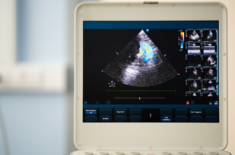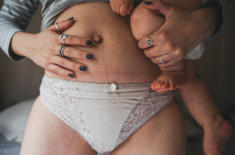What’s Postpartum Thyroiditis?
Are you feeling tired, nervous, or irritable soon after giving birth? That’s expected because your body just went through a major physical experience. Yet these might also be signs of PPT (postpartum thyroiditis), which can occur in as many as 7-10% of new moms. (1)
Thyroiditis is the inflammation of your thyroid gland, a small butterfly-like endocrine gland in your neck that produces hormones for metabolism.
This autoimmune thyroid disease usually develops within the first year following childbirth or, in rare cases, after a miscarriage. (2)
It’s characterized by abnormally high or low thyroid hormone levels: T4 (thyroxine) and (T3) triiodothyronine.
Causes
According to the ATA (American Thyroid Association), postpartum thyroiditis can happen because the immune system experiences sudden changes. It shifts from immunosuppression during pregnancy to its normal function after childbirth. (3)(4)(5)
A 2021 study also showed that women can develop thyroiditis after receiving the SARS-CoV-2 vaccine during the postpartum period. (6)
Risk Factors
Some factors that might put you at an increased risk: (1)(5)
- Autoimmune thyroid diseases, such as Hashimoto’s thyroiditis and Grave’s disease
- Other autoimmune diseases (e.g., type 1 diabetes mellitus, lupus, etc.)
- Previous postpartum thyroiditis
- Chronic viral hepatitis
- Family history
- Presence of antithyroid antibodies during early pregnancy
Thyroid Screening During Pregnancy
Studies show that 50% of pregnant women with antithyroid peroxidase antibodies during early pregnancy develop postpartum thyroiditis. (1)(5)
Screening (TSH and reflex FT4) is recommended for high-risk women.
However, routine thyroid tests aren’t required for pregnant women considered at low risk. But you can ask your doctor about taking the test. (1)
How Is Postpartum Thyroiditis Diagnosed?
Thyroid function tests (blood tests) check for:
- TSH – TSH (thyroid-stimulating hormone)
- Free T4 – unbound thyroxine that can affect tissues
- Total T4 – total thyroxine (bound and unbound)
- Free T3 – unbound triiodothyronine
- Total T3 – total triiodothyronine (bound and unbound)
Low TSH and high Free T4 indicate hyperthyroidism, while high TSH and low Free T4 show primary hypothyroidism. But low TSH and low Free T4 can also indicate a problem with your pituitary gland. (3)
Thyroid antibody tests can help determine the cause of your thyroid condition:
- Thyroid peroxidase antibody
- Thyroglobulin antibody
- TRAb (thyroid receptor stimulating antibodies)
For example, a woman with hypothyroidism who tests positive for antithyroid peroxidase and/or antithyroglobulin antibodies might have autoimmune Hashimoto’s thyroiditis (chronic lymphocytic thyroiditis or chronic inflammation of the thyroid gland). (3)
Other tests include:
- Neck ultrasound – to check for inflammation or nodules (growth)
- RAIU (radioactive iodine uptake) – measures the amount of radioactive iodine absorbed by your thyroid gland
When Should Postpartum Thyroid Levels Be Checked?
High-risk moms need to test for thyroid hormone levels (TSH and reflex FT4) at three and six months postpartum. (1)
Experts recommend yearly TSH (thyroid-stimulating hormone) tests if you have a history of postpartum thyroiditis. (1)
Further screening isn’t necessary for euthyroid moms (with normally functioning thyroid gland) negative for TPO-Ab (thyroid peroxidase antibody).
Types of Postpartum Thyroiditis
Classic
Around 25% of PPT cases start with mild hyperthyroidism anytime during the first six weeks. During this thyrotoxic phase, your inflamed glands release too many hormones. It leads to thyrotoxicosis (high thyroid hormone levels in the blood). (3)
It’s followed by mild hypothyroidism that can last for several months. (3)
Thyroid function eventually normalizes (euthyroid phase) at the end of the first year after childbirth. (4)
Isolated Thyrotoxicosis
Around 30-32% of those with PPT can experience hyperthyroidism starting around two and six months after delivery. Unlike classic PPT, however, it occurs without hypothyroidism. (3)(4)
It’s resolved after thyroid function normalization.
Isolated Hypothyroidism
Around 43-48% of moms with PPT develop an underactive thyroid or mild hypothyroidism. It can start two to three months after delivery and last up to 12 months. (3)(4)
It resolves once your thyroid function is normalized.
What Are The Symptoms Of Postpartum Thyroiditis?
Overactive Thyroid (Hyperthyroidism)
Signs of an overactive thyroid: (3)
- Palpitations (fast heartbeat)
- Feeling warm
- Muscle weakness
- Heat intolerance
- Nervousness
- Anxiety
- Loss of focus
- Weight loss
Underactive Thyroid (Hypothyroidism)
Signs of an underactive thyroid: (5)
- Fatigue (tiredness or lack of energy)
- Muscle cramps
- Dry skin
- Constipation
- Memory loss
- Cold intolerance (such as difficulty handling cold weather)
- Weakness
- Weight gain
How Can I Prevent Postpartum Thyroiditis?
A 2007 clinical trial in The Journal of Clinical Endocrinology and Metabolism showed that selenium could reduce the PPT risks and permanent hypothyroidism. (7)
The study subjects received 200 mcg of selenomethionine per day.
However, the ATA (American Thyroid Association) awaits more studies with similar results before recommending selenium for all pregnant women who test positive for thyroid autoantibodies. (3)(5)
It’s important to note that although doctors recommend iodine supplementation during pregnancy to ensure normal thyroid function for you and your baby, studies show that it might not prevent PPT. (5)
Can Postpartum Thyroiditis Be Cured?
Yes. Essential oils for thyroid support and yoga are some holistic methods to help manage your thyroid condition and its symptoms. There are also plenty of medications for thyroid dysfunction problems (discussed below).
Treatment Options For Postpartum Thyroiditis
Hyperthyroid Treatment
Antithyroid medications treat hyperthyroid conditions because they suppress thyroid activity. The dose can vary depending on your symptoms and condition.
Some studies suggest that MMI (methimazole) can be the better alternative to PTU (propylthiouracil). It might have fewer side effects, such as vasculitis (blood vessel inflammation) or hepatotoxicity (liver injury). (8)
Experts recommend 30 mg of MMI or 450 mg of PTU as the maximum antithyroid medication dose per day for a woman who’s breastfeeding. (1)
Please consult with your doctor if you have a thyroid condition as treatment options and doses will vary for each woman.
Due to concerns that antithyroid drugs can pass to your baby through breastmilk, your doctor might choose beta-blockers (with the lowest possible dose) to manage your symptoms instead of treating your condition. (9)
These medications help reduce your heart rate, tremors, anxiety, and inflammation symptoms. Examples of beta-blockers:
- Metoprolol
- Propranolol
- Atenolol
Hypothyroid Treatment
Here’s a sample treatment plan for the hypothyroid phase: (3)
- Levothyroxine – Your healthcare provider might prescribe this thyroid hormone drug, especially if your TSH levels are higher than 10 mIU/L or you have severe symptoms of hypothyroidism.
- Regular monitoring – Once your TSH levels are under 10 mIU/L, you might no longer need treatment. However, you’ll need regular TSH level tests every four to eight weeks until your thyroid function goes back to normal.
- Levothyroxine (reduction) – Levothyroxine dose is gradually reduced around 6-12 months after starting the treatment. But TSH level monitoring continues to check for signs of permanent hypothyroidism.
- Levothyroxine (extended) – You might need to continue your medication if you want to get pregnant at this time, if you already are, or if you’re breastfeeding. Talk to your healthcare provider about your plans.
Breastfeeding Considerations
Hypothyroidism
Studies show that thyroid hormone replacement medications may be safe for breastfeeding moms and babies. (3)
Hyperthyroidism
The ATA suggests using the lowest possible dose for antithyroid drugs because they can pass to breastmilk.
It’s also important to tell your pediatrician that you’re taking antithyroid medication to monitor your baby’s thyroid function.
How Long Does Postpartum Thyroiditis Last?
Studies have conflicting results, but it’s estimated that 4-54% of moms with PPT might still have hypothyroidism by the end of the first postpartum year. (5)
Is Postpartum Thyroiditis Permanent?
Not all the time, but long-term follow-up studies have similar results: around 20-40% of moms with PPT developed permanent hypothyroidism over the next 3-12 years. (5)
PPT & Postpartum Depression
Studies about the relationship between PPT and postpartum depression have mixed results. However, thyroid hormone levels and function tests can help rule PPT out for PPD diagnosis because they have similar symptoms. (3)
Based on current guidelines, TSH, FT4, and TPO-Ab tests are done for women with postpartum depression symptoms. (1)
REFERENCES
(1) https://www.nps.org.au/australian-prescriber/articles/thyroid-disorders-in-pregnancy-and-postpartum
(2) https://link.springer.com/referenceworkentry/10.1007/978-3-319-29195-6_8-1
(3) https://www.liebertpub.com/doi/full/10.1089/thy.2011.0087
(4) https://oxfordmedicine.com/view/10.1093/med/9780199235292.001.1/med-9780199235292-chapter-346
(5) Stagnaro-Green A., Approach to the Patient with Postpartum Thyroiditis, J Clin Endocrinol Metab (The Journal of Clinical Endocrinology & Metabolism), Volume 97, Issue 2, 1 February 2012, Pages 334–342, https://doi.org/10.1210/jc.2011-2576
(6) https://pesquisa.bvsalud.org/global-literature-on-novel-coronavirus-2019-ncov/resource/en/covidwho-1409863
(7) https://europepmc.org/article/med/17284630
(8) https://www.e-lactancia.org/media/papers/AntithyroidBF-Horm2009.pdf
(9) https://www.hopkinsmedicine.org/health/conditions-and-diseases/postpartum-thyroiditis












